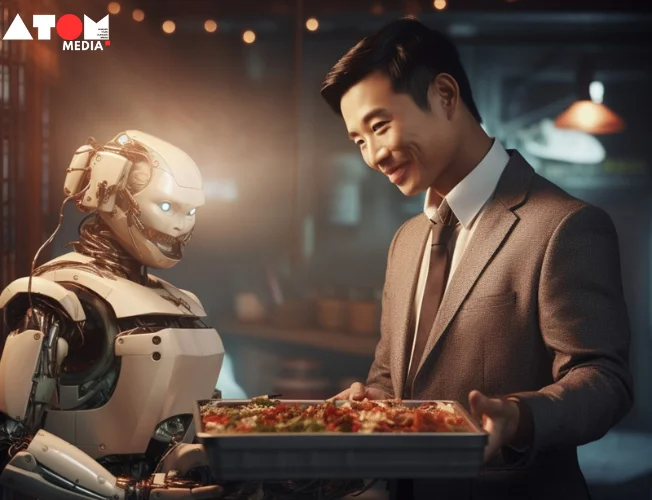The hospitality industry is undergoing a significant transformation driven by technological advancements. One of the most exciting developments is the rise of service robots and the innovative delivery model known as Robotics-as-a-Service (RaaS).
From Sci-Fi to Seamless Integration: The Evolution of Service Robots
Gone are the days when robotic butlers were relegated to science fiction. Today, service robots are becoming a common sight in hotels, seamlessly integrated into various aspects of the guest experience. These robots perform tasks ranging from housekeeping and room service to guest interaction and concierge services. Advancements in artificial intelligence (AI), machine learning, and sensor technology have empowered these robots to navigate complex environments, interact with guests naturally, and perform a wide range of tasks with increasing accuracy and efficiency. This frees up valuable staff time, allowing them to focus on personalized guest interactions and delivering exceptional service.
RaaS: A Game-Changer for Hospitality
Traditionally, acquiring and deploying robots involved significant upfront costs, along with ongoing challenges in maintenance, software upgrades, and scalability. RaaS addresses these concerns by offering robots as a subscription-based service, similar to the software-as-a-service (SaaS) model. This is particularly beneficial for the hospitality sector, which often experiences seasonal fluctuations in demand.
With RaaS, hotels and restaurants can access the latest robotics technology without a substantial capital investment. They simply pay a subscription fee based on usage, covering hardware, software, maintenance, and support services. This not only lowers the barrier to entry for robotics in hospitality but also provides flexibility and scalability. Hotels can adapt their robotic workforce based on occupancy rates and guest needs, ensuring they have the right level of automation at all times.
Enhanced Guest Experiences: The Power of Robots
RaaS offers a multitude of benefits for enhancing guest experiences. Robots can handle repetitive tasks like luggage delivery, room service, and amenity restocking, allowing staff to prioritize guest engagement and deliver personalized service. Additionally, robots can provide multilingual support, catering to a wider range of guest demographics and overcoming language barriers. Imagine a guest arriving at a hotel in a foreign country. A friendly robotic concierge greets them in their native language, assists with check-in, and provides recommendations for local attractions. This can significantly improve the guest’s experience, making them feel welcome and comfortable from the very beginning.
Increased Operational Efficiency: Optimizing Hospitality Operations
RaaS robots go beyond just guest interaction. They can streamline housekeeping tasks, automate back-office processes, and even handle pool and lawn maintenance. This frees up staff time for higher-value activities such as managing guest requests, resolving issues, and providing personalized recommendations. Hotels can operate with a leaner workforce, optimizing operational costs while maintaining a high level of service.
Improved Staff Productivity and Morale: A Shift Towards More Fulfilling Roles
By automating repetitive tasks, RaaS allows staff to focus on more engaging and fulfilling aspects of their roles. Instead of spending their time cleaning rooms or delivering towels, staff can focus on guest interaction and problem-solving. This can lead to increased staff morale, improved job satisfaction, and ultimately, better guest service. Happy and engaged staff are more likely to go the extra mile for guests, creating a positive feedback loop that benefits everyone.
Data-Driven Decision Making: Leveraging Insights for Continuous Improvement
Many RaaS solutions come equipped with valuable data analytics capabilities. These systems can collect data on guest behavior and operational performance. Hotels can leverage this data to personalize guest experiences further, optimize resource allocation, and make data-driven decisions for continuous improvement. For instance, data on guest preferences gathered by robots can be used to personalize room amenities or tailor restaurant recommendations.
Beyond Hospitality: The Widespread Potential of RaaS
While the focus of this article is on hospitality, RaaS holds immense potential for other allied service industries:
Restaurants: RaaS robots can automate food preparation tasks, bus tables, and greet customers, enhancing kitchen efficiency and improving the overall dining experience. Imagine a robot chef assisting human chefs in a busy kitchen, ensuring consistent quality and faster service times.
Food Court Venues: RaaS robots can be deployed for catering services, provide service assistance, and manage larger audience demands, ensuring seamless event operations and enhanced guest safety. During peak hours at a food court, robots can efficiently handle orders and deliveries, reducing wait times and long lines.
Healthcare: RaaS robots can assist with patient care, medication delivery, disinfection, and telepresence, augmenting the capabilities of medical staff and improving patient outcomes. Robots can help with tasks like delivering medication to patients’ rooms or assisting with physical therapy exercises, freeing up nurses and doctors to focus on more complex medical needs.
Airports: RaaS robots can assist with luggage handling, check-in procedures, and navigation, streamlining the passenger journey experience and reducing wait times. Imagine a robot helping you navigate a busy airport
Read more: Marketing News, Advertising News, PR and Finance News, Digital News





